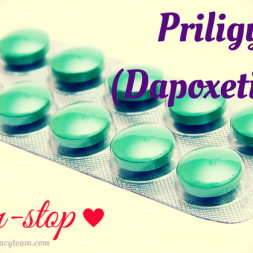[ithshop code=”priligy” tpl=”short” page_id=”1351″ dummy=”txt”]
The following drugs can’t be combined with Canadian Priligy:
Interactions with MAO inhibitors
Patients receiving both SSRI and MAO inhibitors observed serious, sometimes fatal reactions, including hyperthermia, rigidity, myoclonus, autonomic instability with possible rapid fluctuations of the system of vital functions indicators and mental state changes including strong agitation, progressing into delirium and coma. These reactions have also been observed in patients who have recently withdrawn SSRIs and started treatment with MAO inhibitors. In some cases, symptoms resembled neuroleptic malignant syndrome.
Data on combined use of SSRIs and MAO inhibitors in animals suggest that these drugs may synergistically increase arterial blood pressure and cause behavioral excitement. Therefore, Priligy should not be taken with MAO inhibitors simultaneously and 14 days after their admission cessation. Likewise, MAO inhibitors should not be taken within 7 days after this drug withdrawal.
 Interaction with Thioridazine
Interaction with Thioridazine
Thioridazine prolongs QTc interval, which is accompanied by ventricular fibrillation. Drugs that inhibit CYP2D6 enzyme, appears to inhibit thioridazine metabolism. It is expected that caused by this increase in thioridazine level will prolong QTc interval. Priligy should not be taken with thioridazine simultaneously and 14 days after its admission cessation. Likewise, thioridazine should not be taken within 7 days after its withdrawal.
Medications with Serotonergic Effect
As with SSRIs, this PE drug administration simultaneously with serotonergic medications (including MAO inhibitors, L-tryptophan, triptans, tramadol, linezolid, SSRIs, inhibitors of serotonin and norepinephrine, lithium, and St John’s wort drugs (Hypericum perforatum)) may increase serotoninergic side effects. Generic Dapoxetine) should not be taken with other SSRIs, MAOIs or other serotonergic agents simultaneously and 14 days after these drugs withdrawal. Likewise, these drugs should not be taken within 7 days after withdrawal.
Drugs with Effect on CNS
This PE medication administration simultaneously with drugs acting on the central nervous system in patients with premature ejaculation has not been studied. Caution advised being taken if it is necessary to take these drugs together.
Influence of Other Drugs on Dapoxetine Hydrochloride
Studies with human liver microsomes, kidney and intestines in vitro showed that dapoxetine is metabolized mainly by CYP2D6, CYP3A4 and flavin-containing monooxygenase 1 (PMO1). Therefore, inhibitors of these enzymes may reduce dapoxetine clearance.
CYP3A4 Inhibitors
Active CYP3A4 Inhibitors
Ketoconazole in a dosage of 200 mg 2 times a day during 7 days increased Cmax and AUC0-∞ of dapoxetine (60 mg single dose), by 35% and 99% respectively. Taking into account proportion of unbound dapoxetine and desmethyl dapoxetine, Cmax of active fraction (amount of unbound dapoxetine and desmethyl dapoxetine) in presence of active CYP3A4 inhibitors may increase by about 25%, AUC can be doubled. This increase in Cmax and AUC of an active fraction can be much more pronounced in a subpopulation of patients who have no functionally active enzyme, and also while receiving active CYP2D6 inhibitors.
This drug should not be taken simultaneously with active CYP3A4 inhibitors, such as ketoconazole, itraconazole, ritonavir, saquinavir, telithromycin, nefazodone, nelfinavir and atazanavir.
Moderately Active CYP3A4 Inhibitors
Concomitant use of moderately active CYP3A4 inhibitors, such as erythromycin, clarithromycin, fluconazole, amprenavir, fosamprenavir, aprepitant, diltiazem or verapamil, can significantly increase the level of dapoxetine and desmethyl dapoxetine systemic exposure, especially in patients with low CYP2D6 activity. The maximal dosage of generic Priligy received simultaneously with these drugs should be limited to 30 mg and taken with caution.
Active CYP2D6 Inhibitors
Taking fluoxetine in a dosage of 60 mg/day for 7 days increased Cmax and AUC0-∞ of dapoxetine (60 mg single dose), 50% and 88% respectively. Taking into account proportion of unbound dapoxetine and desmethyl dapoxetine, Cmax of active fraction (amount of unbound dapoxetine and desmethyl dapoxetine) in presence of active CYP2D6 inhibitors may increase by about 50%, AUC can be doubled. This increase in Cmax and AUC of the active fraction is close to that expected in patients with low CYP2D6 activity and may increase frequency and severity of dose-dependent adverse reactions.
Therefore, caution is advised to be taken when increasing Priligy dosage to 60 mg in patients receiving active CYP2D6 inhibitors and in patients with low CYP2D6 activity.
Interaction with Drugs Metabolized by CYP1A and CYP2B6 isoenzymes
Based on comparative data dapoxetine Cmax when taking 60 mg of the drug and dapoxetine concentration at 50% inhibition (IC50) of CYP1A2 isoenzyme in vitro, it was concluded that dapoxetine influence on the concentration of simultaneously prescribed drugs, metabolized by this isoenzyme, is not expected. Influence of dapoxetine on CYP2B6 isoenzyme has not been studied.
PDE-5 Inhibitors
There were studies on dapoxetine pharmacokinetics received at dosage of 60 mg together with tadalafil (20 mg) and sildenafil (100 mg). Tadalafil did not affect dapoxetine pharmacokinetics. Sildenafil significantly increased AUC0-∞ and Cmax of dapoxetine (22% and 4% respectively), which is considered not clinically significant. The medications with the same active ingredient should be used with caution by patients taking PDE-5 inhibitors due to possible reduced tolerance of these patients to orthostatic hypotension.
Influence of Dapoxetine Hydrochloride on Drugs, Taken Simultaneously
Tamsulosin
Single and multiple receptions of the drug in doses of 30 mg and 60 mg by patients taking tamsulosin daily did not change the pharmacokinetics of the latter. It also did not change orthostatic hypotension rate, which was the same when receiving tamsulosin alone or in combination with dapoxetine 30 mg or 60 mg. Priligy should be used with caution by patients taking alpha-blockers, because of the possibility of tolerance reduction of these patients to orthostatic hypotension.
Drugs, Metabolized by CYP2D6
Multiple described medication receptions (60 mg/day during 6 days) increased Cmax and AUC 0-∞ of desipramine (50 mg single dose) by 11% and 19% respectively, compared to desipramine reception alone. Dapoxetine can likewise increase the concentration of other drugs, metabolized by CYP2D6, in blood plasma. Clinical relevance of this phenomenon is likely to be small.
Drugs, Metabolized by CYP3A
Multiple receptions of Priligy (60 mg/day for 6 days) reduced AUC0-∞ of midazolam (8 mg single dose) approximately by 20% (range from -60% to +18%). Clinical relevance of this phenomenon in the majority of patients is likely to be small. However, increase in CYP3A activity may be of clinical relevance in some patients simultaneously taking medications metabolized mainly by CYP3A and having a narrow therapeutic window.
Drugs, Metabolized by CYP2C19
Multiple receptions of generic Priligy (60 mg/day for 6 days) did not affect the pharmacokinetics of omeprazole (40 mg single dose). Dapoxetine is unlikely to affect the pharmacokinetics of other CYP2C19 substrates.
Drugs, Metabolized by CYP2C9
 Multiple reception of Dapoxetine (60 mg/day for 6 days) did not affect pharmacokinetics and pharmacodynamics of glyburide (5 mg single dose). Dapoxetine is unlikely to affect pharmacokinetics of other CYP2C9 substrates.
Multiple reception of Dapoxetine (60 mg/day for 6 days) did not affect pharmacokinetics and pharmacodynamics of glyburide (5 mg single dose). Dapoxetine is unlikely to affect pharmacokinetics of other CYP2C9 substrates.
PDE-5 Inhibitors
Study results showed that dapoxetine (60 mg) did not affect the pharmacokinetics of tadalafil (20 mg) and sildenafil (100 mg).
Warfarin
There are no data on effects of long-term use of warfarin in combination with Priligy. In a study of pharmacokinetics, multiple doses of dapoxetine (60 mg/day for 6 days) did not affect pharmacokinetics and pharmacodynamics (PT and MHO) of warfarin (25 mg single dose).
Posted by Dr. Himanshu Singh

 English
English Deutsch
Deutsch Français
Français Italiano
Italiano Español
Español Svenska
Svenska Português
Português 日本人
日本人 Dansk
Dansk Norsk
Norsk Suomi
Suomi Czech
Czech


